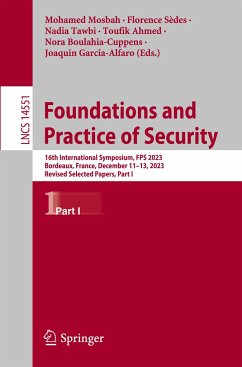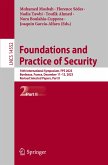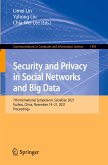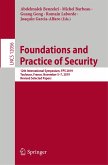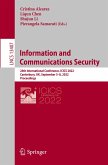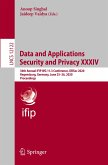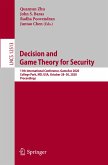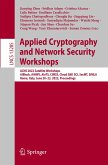Foundations and Practice of Security
16th International Symposium, FPS 2023, Bordeaux, France, December 11-13, 2023, Revised Selected Papers, Part I
Herausgegeben:Mosbah, Mohamed; Sèdes, Florence; Tawbi, Nadia; Ahmed, Toufik; Boulahia-Cuppens, Nora; Garcia-Alfaro, Joaquin
Foundations and Practice of Security
16th International Symposium, FPS 2023, Bordeaux, France, December 11-13, 2023, Revised Selected Papers, Part I
Herausgegeben:Mosbah, Mohamed; Sèdes, Florence; Tawbi, Nadia; Ahmed, Toufik; Boulahia-Cuppens, Nora; Garcia-Alfaro, Joaquin
- Broschiertes Buch
- Merkliste
- Auf die Merkliste
- Bewerten Bewerten
- Teilen
- Produkt teilen
- Produkterinnerung
- Produkterinnerung
This book constitutes the refereed proceedings of the 16th International Symposium on Foundations and Practice of Security, FPS 2023, held in Bordeaux, France, during December 11-13, 2023. The 27 regular and 8 short papers presented in this book were carefully reviewed and selected from 80 submissions. The papers have been organized in the following topical sections: Part I: AI and cybersecurity, security analysis, phishing and social network, vulnerabilities and exploits, network and system threat, malware analysis. Part II : security design, short papers.
Andere Kunden interessierten sich auch für
![Foundations and Practice of Security Foundations and Practice of Security]() Foundations and Practice of Security42,99 €
Foundations and Practice of Security42,99 €![Security and Privacy in Social Networks and Big Data Security and Privacy in Social Networks and Big Data]() Security and Privacy in Social Networks and Big Data49,99 €
Security and Privacy in Social Networks and Big Data49,99 €![Foundations and Practice of Security Foundations and Practice of Security]() Foundations and Practice of Security38,99 €
Foundations and Practice of Security38,99 €![Information and Communications Security Information and Communications Security]() Information and Communications Security76,99 €
Information and Communications Security76,99 €![Data and Applications Security and Privacy XXXIV Data and Applications Security and Privacy XXXIV]() Data and Applications Security and Privacy XXXIV38,99 €
Data and Applications Security and Privacy XXXIV38,99 €![Decision and Game Theory for Security Decision and Game Theory for Security]() Decision and Game Theory for Security38,99 €
Decision and Game Theory for Security38,99 €![Applied Cryptography and Network Security Workshops Applied Cryptography and Network Security Workshops]() Applied Cryptography and Network Security Workshops38,99 €
Applied Cryptography and Network Security Workshops38,99 €-
-
-
This book constitutes the refereed proceedings of the 16th International Symposium on Foundations and Practice of Security, FPS 2023, held in Bordeaux, France, during December 11-13, 2023.
The 27 regular and 8 short papers presented in this book were carefully reviewed and selected from 80 submissions. The papers have been organized in the following topical sections:
Part I: AI and cybersecurity, security analysis, phishing and social network, vulnerabilities and exploits, network and system threat, malware analysis.
Part II : security design, short papers.
The 27 regular and 8 short papers presented in this book were carefully reviewed and selected from 80 submissions. The papers have been organized in the following topical sections:
Part I: AI and cybersecurity, security analysis, phishing and social network, vulnerabilities and exploits, network and system threat, malware analysis.
Part II : security design, short papers.
Produktdetails
- Produktdetails
- Lecture Notes in Computer Science 14551
- Verlag: Springer / Springer Nature Switzerland / Springer, Berlin
- Artikelnr. des Verlages: 978-3-031-57536-5
- Seitenzahl: 480
- Erscheinungstermin: 25. April 2024
- Englisch
- Abmessung: 235mm x 155mm x 26mm
- Gewicht: 721g
- ISBN-13: 9783031575365
- ISBN-10: 3031575369
- Artikelnr.: 70022769
- Herstellerkennzeichnung
- Springer-Verlag KG
- Sachsenplatz 4-6
- 1201 Wien, AT
- ProductSafety@springernature.com
- Lecture Notes in Computer Science 14551
- Verlag: Springer / Springer Nature Switzerland / Springer, Berlin
- Artikelnr. des Verlages: 978-3-031-57536-5
- Seitenzahl: 480
- Erscheinungstermin: 25. April 2024
- Englisch
- Abmessung: 235mm x 155mm x 26mm
- Gewicht: 721g
- ISBN-13: 9783031575365
- ISBN-10: 3031575369
- Artikelnr.: 70022769
- Herstellerkennzeichnung
- Springer-Verlag KG
- Sachsenplatz 4-6
- 1201 Wien, AT
- ProductSafety@springernature.com
AI and Cybersecurity.- An Adversarial Robustness Benchmark for Enterprise Network Intrusion Detection.- Securing Smart Vehicles through Federated Learning.- Using Reed-Muller Codes for Classification with Rejection and Recovery.- Unsupervised Clustering of Honeypot Attacks by Deep HTTP Packet Inspection.- Security Analysis.- Practices for Assessing the Security Level of Solidity Smart Contracts.- Effectiveness of Binary-Level CFI Techniques.- A Small World-Privacy Preserving IoT Device-type Fingerprinting with Small Datasets.- URSID: Automatically Refining a Single Attack Scenario into Multiple Cyber.- Phishing and Social Network.- Does the Anchoring Effect Influence Individuals' Anti-Phishing Behavior?.- IntelliTweet: a Multifaceted Feature Approach to Detect Malicious Tweets.- Web Scams Detection System.- Vulnerabilities and Exploits.- VulMAE: Graph Masked Autoencoders for VulnerabilityDetection from Source and Binary Codes.- Analysis of Cryptographic CVEs: Lessons Learned and Perspectives.- A BERT-Based Framework for Automated Extraction of Indicators of Compromise from Security Incident Reports.- Enhancing Code Security Through Open-source Large Language Models: A Comparative Study.- Network and System Threat.- Green-Fuzz: Efficient Fuzzing for Network Protocol Implementations.- Unmasking of Maskware: Detection and Prevention of Next-Generation Mobile Crypto-Ransomware.- Automated Attacker Behaviour Classification Using Threat Intelligence Insights.- UDP state manipulation: description of a Packet Filtering vulnerability in Stateful firewalls.- Malware Analysis.- Following the Obfuscation Trail: Identifying and Exploiting Obfuscation Signatures in Malicious Code.- On Exploiting Symbolic Execution to Improve the Analysis of RAT Samples with angr.- Original Entry Pointdetection based on graph similarity.- Attacking and Securing the Clock Randomization and Duplication Side-Channel Attack Countermeasure.- Security Design.- Hardening Systems Against Data Corruption Attacks at Design Time.- Design of an Efficient Distributed Delivery Service for Group Key Agreement Protocols.- A shared key recovery attack on a masked implementation of CRYSTALS-Kyber's encapsulation algorithm.- Tight Differential Privacy Guarantees for the Shuffle Model with k-Randomized Response.
AI and Cybersecurity.- An Adversarial Robustness Benchmark for Enterprise Network Intrusion Detection.- Securing Smart Vehicles through Federated Learning.- Using Reed-Muller Codes for Classification with Rejection and Recovery.- Unsupervised Clustering of Honeypot Attacks by Deep HTTP Packet Inspection.- Security Analysis.- Practices for Assessing the Security Level of Solidity Smart Contracts.- Effectiveness of Binary-Level CFI Techniques.- A Small World-Privacy Preserving IoT Device-type Fingerprinting with Small Datasets.- URSID: Automatically Refining a Single Attack Scenario into Multiple Cyber.- Phishing and Social Network.- Does the Anchoring Effect Influence Individuals' Anti-Phishing Behavior?.- IntelliTweet: a Multifaceted Feature Approach to Detect Malicious Tweets.- Web Scams Detection System.- Vulnerabilities and Exploits.- VulMAE: Graph Masked Autoencoders for VulnerabilityDetection from Source and Binary Codes.- Analysis of Cryptographic CVEs: Lessons Learned and Perspectives.- A BERT-Based Framework for Automated Extraction of Indicators of Compromise from Security Incident Reports.- Enhancing Code Security Through Open-source Large Language Models: A Comparative Study.- Network and System Threat.- Green-Fuzz: Efficient Fuzzing for Network Protocol Implementations.- Unmasking of Maskware: Detection and Prevention of Next-Generation Mobile Crypto-Ransomware.- Automated Attacker Behaviour Classification Using Threat Intelligence Insights.- UDP state manipulation: description of a Packet Filtering vulnerability in Stateful firewalls.- Malware Analysis.- Following the Obfuscation Trail: Identifying and Exploiting Obfuscation Signatures in Malicious Code.- On Exploiting Symbolic Execution to Improve the Analysis of RAT Samples with angr.- Original Entry Pointdetection based on graph similarity.- Attacking and Securing the Clock Randomization and Duplication Side-Channel Attack Countermeasure.- Security Design.- Hardening Systems Against Data Corruption Attacks at Design Time.- Design of an Efficient Distributed Delivery Service for Group Key Agreement Protocols.- A shared key recovery attack on a masked implementation of CRYSTALS-Kyber's encapsulation algorithm.- Tight Differential Privacy Guarantees for the Shuffle Model with k-Randomized Response.

